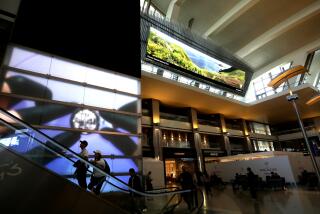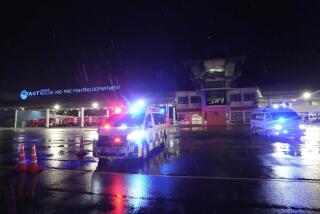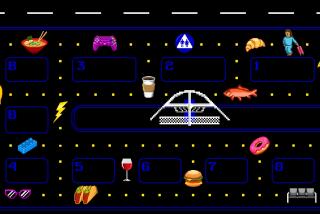Two Airports That Work : Singaore’s Changi Consistently Wins the Votes as World’s Best
SINGAPORE — I hate airports. Hate the watch-us-grow plywood walls, the hard orange plastic chairs, and feeding stations whose chef d’oeuvre is a hard orange plastic “cheese” sandwich, $8 and tax. Hate those snotty little golf carts that whiz up behind me on the concourse and beep as though I were clogging the autobahn.
Airports are places with check-in lines. Check-in lines are places where I’m the only traveler not returning to her native land with a washer-dryer combination for Mom or a wedding cake in an oil drum for Sis. Airports are crowded and dirty and their public address systems carry announcements that are equally unintelligible to Americans and Argentines. Did he say, “Air Niugini Flight 2 now boarding for Tenerife with intermediate stops at Toronto and Taipei,” or is that the flight to Toledo?
Like everybody else, I hate airport boredom most of all. Displays of local products--stretch watchbands, truck bumpers, walnut ketchup--are only briefly diverting. Television sets permanently tuned to talk shows remind me of the 24 hours I spent in a shared hospital room after I ate a bad scallop.
But wait. None of the above applies to Singapore Changi Airport. And Changi’s not just my favorite airport. It has repeatedly been voted best in the world in polls of business travelers, including the readers of London-based Business Traveller magazine, who recently named it the world’s best airport for an unprecedented fifth consecutive year.
Opened 11 years ago, Changi now claims to be Asia’s busiest airport, thanks in part to its location at the crossroads of Asia and the Pacific Rim. The Civil Aviation Authority of Singapore (CAAS) notes that at the end of last year, 2,212 flights a week operated through Changi, compared with 1,900 for Hong Kong’s Kai Tak and 1,654 at Bangkok’s Don Muang.
Despite the fast growth, however, no temporary plywood greets travelers at Changi. Instead, passengers flow gape-jawed through the airport’s two international terminals with their trickling brooks, waterways with black and orange koi fish, splashing fountains, gardens, recorded bird song and pianists tinkling away at show tunes during cocktail hour. Signs are large, easy to read and in English, which is spoken nearly everywhere in this city-state founded by the British. Public address announcements are spoken as clearly as if a BBC reader were at the microphone.
Travelers arriving from the United States are likely to enter through Terminal 2, a six-story central structure with two four-story wings that opened on Nov. 22, 1990. The new terminal gave Singapore Changi Airport an annual passenger capacity of 24 million, largest of any Asia-Pacific airport, according to CAAS.
And although as many as 5,000 passengers pass through the newer building each hour, both terminals are stunningly bright and clean. Cleanliness is viewed as a civic duty in the Republic of Singapore, where regulations against spitting are strictly enforced; the manufacture, sale and importation of chewing gum is an offense that can bring a fine and up to a year in jail (it is deemed to cause uncleanliness in public facilities), and failing to flush a public toilet can bring a citation. In other words, the same strict central planning that created Singapore’s postwar economic miracle applies to public behavior. And Singaporeans appear happy to go along with the system that has lifted their island from its former poor living conditions to the current embrace of technology and individual upward mobility.
Once Terminal 2 was in operation, the Aviation Authority turned its attention to refurbishing Terminal 1. Planned new amenities include a swimming pool. Not even a teen-ager yet, the earlier terminal was hardly showing signs of age, but the government of Singapore clearly believes in keeping ahead of current needs. That’s why plans are now moving ahead for--what else--Terminal 3.
Singapore Airlines now uses Terminal 2, as do others including Swissair, Finnair, Malaysia Airlines and Royal Brunei. The terminal’s efficiency quotient dictates getting the last passenger off the largest plane, through immigration, baggage claim and customs, into a cab and well on the way to downtown Singapore in less than 30 minutes. The airlines operate from 24 counters and 132 check-in sites so that no one need be stuck for long behind a wedding cake, and there is a baggage system that can handle 10,700 bags, washer-dryers or oil drums per hour.
For departing flights, the baggage security system begins near the entrance where bags are scanned and a device automatically whips a tight tape around each bag, which then continues to a final check-point inside each departure lounge.
But it is the orchids that get me. They were an afterthought.
When the Aviation Authority surveyed employees to see how they felt about working in Terminal 2, many responded that the place looked a bit umm, bare. Those acres of pastel tile and hectares of carpeting needed something. More color, perhaps. There were generous gardens of greenery in huge rectangular containers with custom-designed irrigation systems. But yes, perhaps some flowers would help. The CAAS thought it over and decided that Singapore’s national flower, the orchid, might fill the bill. Now, one of the first sights that greets a passenger arriving at Terminal 2 is a “bed” of potted orchids, rotated and replaced regularly. Others are strategically placed throughout the terminal.
What else can you say about an airport where orchids grow? You can say it has the best airport food on earth. Changi has a dozen restaurants that uphold Singapore’s reputation for glorious food in great variety.
The largest segment of Singapore’s ethnically-rich population is Chinese; there are also large Indian and Malay populations. The culinary traditions of several regions of China are represented at Changi as they are in local restaurants and hawker centers. From the abalone at Fook Yuen Cantonese restaurant to Teochew steamed fish with sour plums at Swatow, there’s Chinese aplenty. There are Indonesian satays at Bali Indonesian and sashimi at Udai-Jin, Thai shark’s fin at Siam Garden, and Muslim lamb at the Palms. I can’t remember seeing any cheese sandwiches but the shrimp in banana rolls helps to compensate.
Some of the best restaurants in Terminal 2 are clustered on the third story in an area called the Viewing Mall, which offers wide-angle views of the runways and aprons. There are some fast food outlets on lower floors. Although I didn’t have time for a sit-down meal, I checked out several menus and was told often that the food in Changi’s sit-down eateries matches the high quality of downtown restaurants. The prices in airport restaurants and gift shops are competitive with downtown as well. Shops? Oh. Yes. Shops that go far beyond T-shirts and the oeuvre of Tom Clancy and Danielle Steel. Terminal 2 alone has more than 50 of them, including duty-free liquor and tobacco shops. On a quick tour this year, I made a few notes: Chinese silk kimonos and Indonesian batik shirts, Havana cigars, Hermes ties, a Silent Knight anti-snore pillow to prevent in-flight embarrassment, Naf Naf lingerie. A Logicraft Notebook PC, Swiss chocolate, dried mangoes, beef jerky strips for those minutes between meals on the long flight across the Pacific, gold wedding bands, books on how to do business in Asia, copies of The Economist from Britain, Der Spiegel from Germany, and The Reader’s Digest from the United States.
I could have had prescription eyeglasses made in 15 minutes at Milan Optics while trying on Mizuno golf shoes at the Royal Sporting House. I could have my film processed. I could buy orchids, fresh ones, gold-plated ones, ceramic ones.
But curiously, neither orchids nor earthen pot cookery figures in the repeated choice of Changi as the world’s best airport. The recent Business Traveller poll cited Changi for excellence in passport control, luggage handling, and customs clearance. It received a record 59% of the votes from that magazine’s much traveled subscribers; with 11%, Amsterdam’s Schiphol Airport was a distant second, and London’s Heathrow and Zurich’s Kloten tied for third with 4% of the votes each.
Changi has also been called the best in the world by Euromoney magazine, another British publication; and U.S.-based Business Traveler International. Travel Trade Gazette, which circulates in Asia and the Pacific, called Changi “best airport.” Arrival magazine called it “best international airport” and Cargonews named it “best airport for air cargo handling in Asia.”
Changi has been in operation only since July 1981, when it replaced Paya Lebar, a 26-year-old airport whose capacity was being overburdened by growing traffic through this Asia-Pacific crossroads. On the eastern tip of the island, Changi was built on a site that had been used as an air base by the Japanese during their World War II occupation of Singapore. Additional land was reclaimed from the sea.
During its first year, the new airport handled 8.1 million passengers and 63,100 takeoffs and landings. As Singapore developed as a center of business and tourism, air traffic kept pace. Airline passenger traffic in and out of Changi made steady gains of about 7% a year, then jumped 10.5% in 1990 over 1989, to more than 15.6 million passengers.
Today, 57 international airlines operate scheduled passenger service through Changi to 110 cities in 53 countries. Some destinations listed on the overhead boards are the names from novels by Joseph Conrad or Somerset Maugham: Balikpapan, Bangkok, Denpasar, Kota Kinabalu, Phuket, Port Moresby, Surabaya. But also among the 2,250 flights arriving and departing each week is service to Canton, Copenhagen, London, Helsinki, Geneva, Dubai, Los Angeles. Both Singapore Airlines and United have daily flights between Los Angeles and Singapore.
But what impresses most travelers passing through Changi is not how busy it is, or how efficient, but how much there is to do there. On the third floor of the departure/transit lounge in Terminal 2 there’s a lively science museum for adults and children full of solar-powered, moving, flashing, jiggling, teasing problems to solve. It also has a greeting robot, a hologram, a knob-operated dancing laser, and an exhibit that allows a visitor to superimpose his or her image onto the face of a friend. The terminal has a hairdressing salon, fitness center and a supermarket that sells fresh ginger and Malaysian hot sauce along with other things that the airport’s 22,000 employees might have on their shopping lists. I bought a bottle of ferociously hot chili-crab sauce bottled by Tan Kimhock in Malaysia.
Elsewhere in the vast terminal are a business center and children’s play area and nursery whose furniture and plumbing fixtures are scaled to small travelers. Baby-sitters are available. There are banks, a medical center, and a hotel. Also in the departure/transit lounge, the hotel’s 56 rooms are intended for passengers with long waits between planes, but they’re not the usual minimalist day-room accommodations. Some bathrooms have tubs as well as showers and there are pictures on the walls. Rooms run $50-$57 per six-hour stay.
For transit passengers with less time on their hands, a computer-controlled skytrain, Asia’s first, makes the trip between the two terminals in just one minute.
Some passengers with several hours between planes may decide that sleep is something to do at home. There’s a famous city down the road and those with four hours between planes can tour it free, courtesy of the Singapore Tourist Promotion Board and other sponsors.
Betting that travelers who spend two hours in Singapore will come back for more, these hosts offer two complimentary tours a day, at 2:30 and 4:30 p.m., times when many passengers may have to wait for connecting flights. Sign-up is at booths easily located in the departure areas of both terminals.
The two-hour tour dips into several of the city’s most colorful ethnic enclaves: The colonial area with its imposing white 19th-Century buildings set in green parkland; the tangled streets of Singapore’s shrinking Chinatown where laundry hangs on poles from upper windows of shophouses and above the open fronts of noodle shops; Sri Mariamman Temple, the oldest Hindu temple in Singapore; Serangoon Road in Little India, where shops are stocked with bolts of sari silk, tapes of traditional Hindu ragga music, and packets of spices, and finally, Orchard Road, Singapore’s eye-popping street of shopping towers (electronics, cameras, watches, jewelry) and luxury hotels (Dynasty, Meridien, Mandarin, Hilton). Then it’s back along the 12.4-mile road to the airport, sea-edged, lined for most of its length by tropical foliage and flowers.
The tour misses Arab Street with its straw and batik shops, the zoo, the aviary, Asia’s largest tropical fish oceanarium, the Chinese mythological theme park, the ethnic food centers filled with exotic fruits, vegetables, fish, spices, and prepared foods. There’s no time for Raffles Center, the crocodile parks or Mandai Orchid Gardens, a commercial orchid farm where 10 acres of spectacular orchids flourish like daisies in a hayfield.
But of course there are orchids at Changi. And when you finally get to the departure lounge, there’s another surprise: inescapable, endlessly-droning television, just like back home. Nobody’s perfect.
More to Read
Sign up for The Wild
We’ll help you find the best places to hike, bike and run, as well as the perfect silent spots for meditation and yoga.
You may occasionally receive promotional content from the Los Angeles Times.






